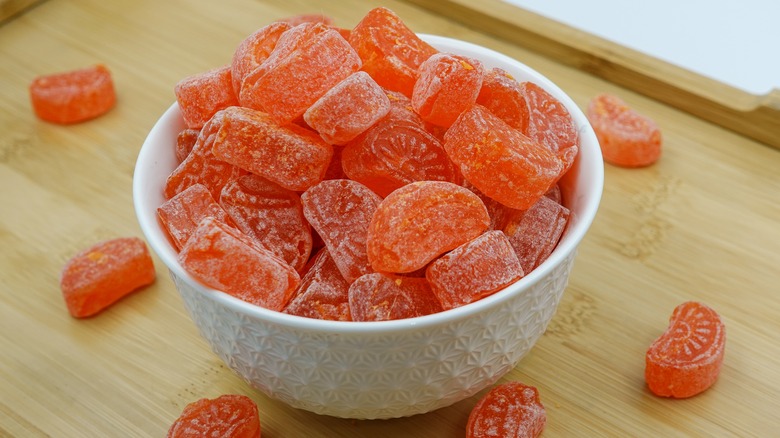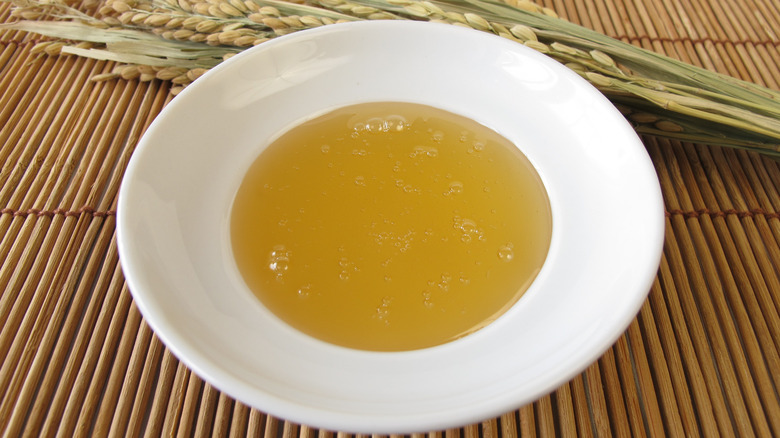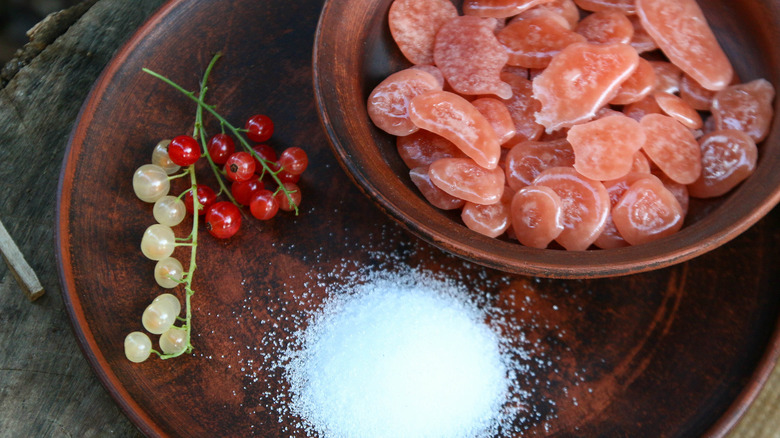The Best Corn Syrup Substitute For Homemade Candy
Finding the best corn syrup substitute isn't always easy, depending on how you plan to use it. According to Cook's Illustrated, this sweetener has a higher viscosity than molasses, honey, and other similar ingredients. Therefore, it's ideal for homemade candy, sorbets, and ice cream. It also gives cookies a chewy texture, prevents your fudge from getting grainy, and prevents sugar crystals from forming in ice cream and other homemade desserts.
This sweet ingredient comes from corn starch, which is treated with acids or enzymes. Manufacturers may also add vanilla, molasses, or other flavorings, depending on the desired result. Corn starch consists of long chains of glucose molecules — hence the viscosity of the syrup, notes Cook's Illustrated. High-fructose corn syrup (HFCS), a similar ingredient, undergoes further processing for extra sweetness. The primary difference is that pure corn syrup is 100% glucose, whereas HFCS contains around 55% fructose and 42% glucose, per the U.S. Food and Drug Administration. Therefore, the latter is sweeter but less viscous.
Unfortunately, corn syrup isn't widely available in stores. You may find it at your local supermarket, but it's not the same as the real thing. Most stores sell light or dark corn syrup, a product that's about half glucose and half maltose. These products are less sweet and have a lower viscosity than pure corn syrup, says Cook's Illustrated. With that in mind, consider using the following substitutes for corn syrup when making candy.
Try these corn syrup substitutes in candy recipes
MasterClass recommends using agave nectar, maple syrup, or light treacle as a substitute for corn syrup. However, none of these sweeteners is a good choice for homemade candy. For example, agave nectar is about 20% glucose and 80% fructose, according to Food Insight. Because it has a thin consistency, it works best in beverages, sauces, and soft foods. The same goes for brown rice syrup, cane syrup, honey, and other low-glucose sweeteners.
A better option is glucose syrup, a product derived from wheat, rice, potatoes, or corn. Just like corn syrup, this ingredient prevents sugar crystallization and gives candies a glossy finish, according to the European Starch Industry Association. Plus, it can increase the shelf-life of food products and keep your freshly baked cookies soft.
Alternatively, you can use tapioca syrup, a sweetener made from cassava root. It's high in glucose, with a neutral flavor and no artificial colors, notes California Gummy Bears. Moreover, it has half the calories of corn syrup and varying levels of sweetness, depending on the brand.
A similar option is rice syrup, a natural sweetener with high viscosity. According to Nutritional Outlook, this ingredient has pretty much the same physical and chemical properties as corn syrup. You can use it in honeycomb candy recipes, homemade Pop Rocks, lollipops, and other delicious treats.
What about natural sweeteners?
Sugar is sugar, no matter where it comes from. When consumed in excess, this sneaky ingredient can put you at risk for heart disease, stroke, diabetes, and liver disorders, warns Harvard Medical School. Glucose, the primary component of corn syrup, is no better than sucrose, or table sugar. Molasses, agave nectar, cane syrup, and treacle are not healthier, either. However, this doesn't mean you must give up candy or other homemade treats.
Arman Liew, a recipe developer at The Big Man's World, suggests using natural sweeteners instead of sugar. His candy recipe calls for butter, vanilla extract, heavy cream, and a natural sweetener, such as erythritol or allulose. The latter is a naturally occurring sugar in figs, raisins, and other fruits, notes WebMD. It's about 30% less sweet than table sugar and has very few calories.
Erythritol, a sugar alcohol that has only 0.2 calories per gram, can be used in candy recipes, too. This natural sweetener has a negligible effect on blood glucose levels and may protect against oxidative stress, according to clinical research published in the journal Applied Microbiology and Biotechnology. For example, MiiRO recommends mixing it with water, flavoring oil, and plant-based food colorings to make sugar-free hard candies at home.


